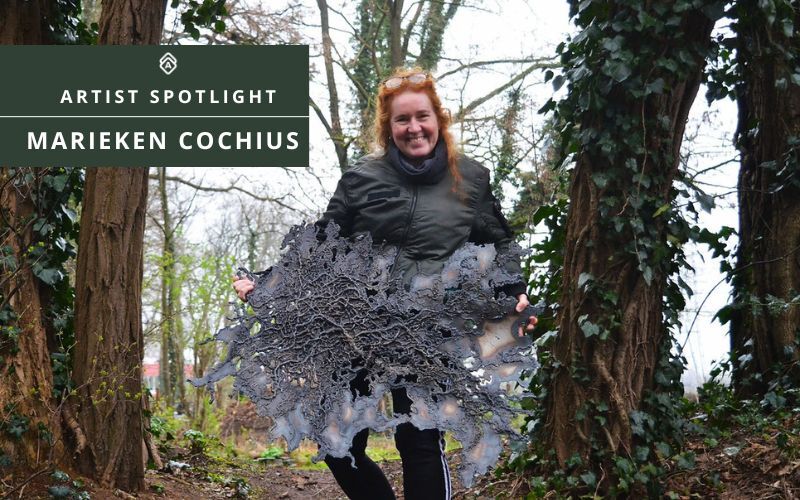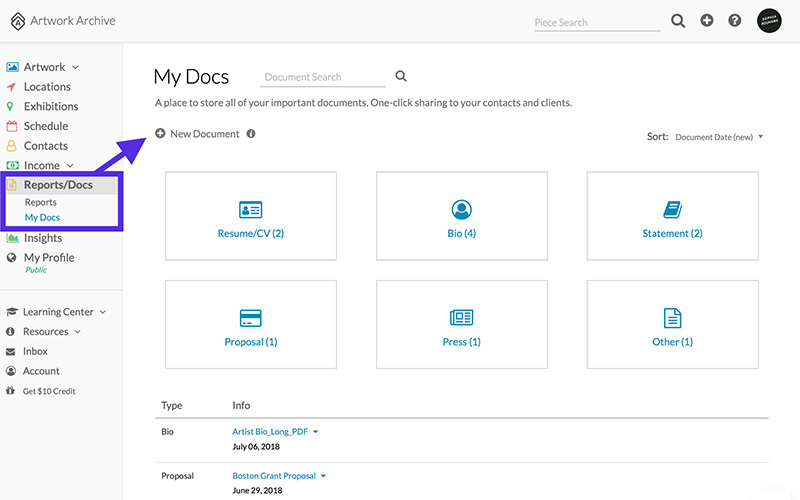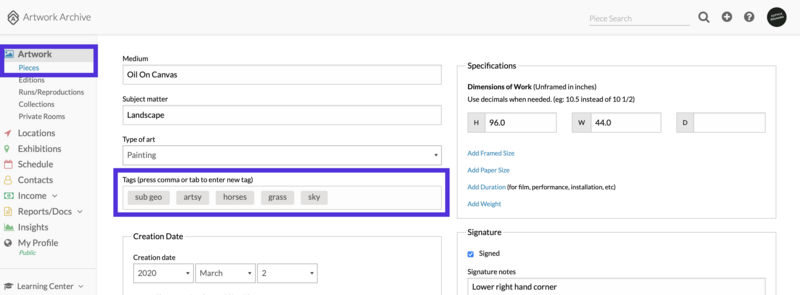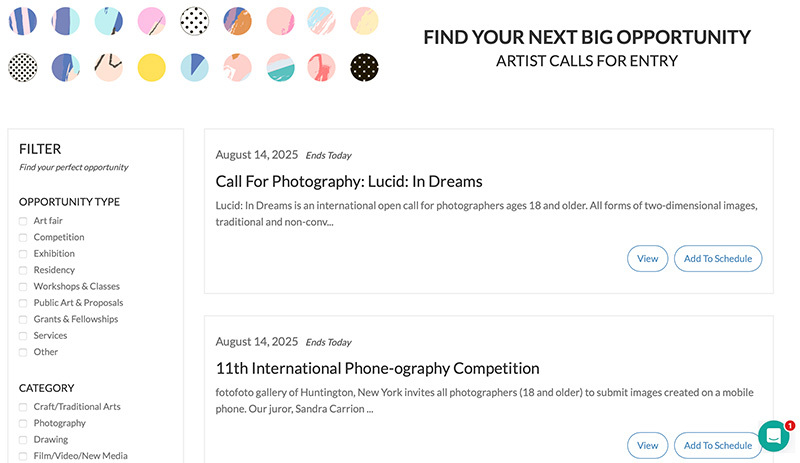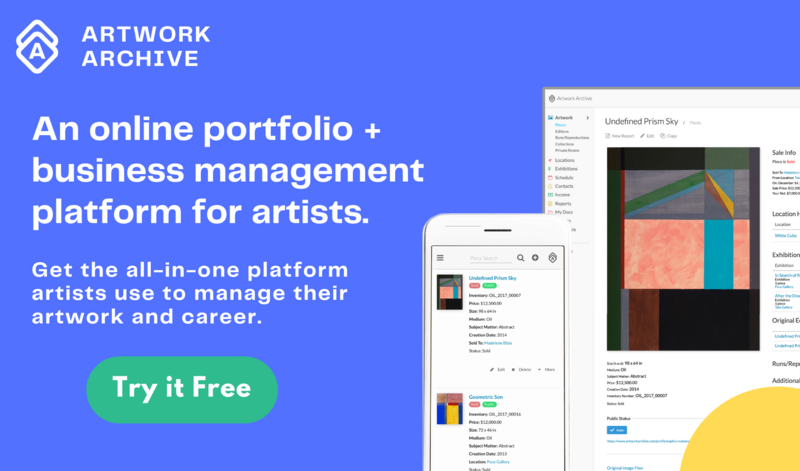“I use a welder like a drawing tool.”
The instinct to treat fire and steel as an extension of her own hand is at the center of Featured Artist Marieken Cochius' practice.
In her hands, materials take on a second life. Steel moves like ink. Bone becomes a sketch. Layers of oil and pigment feel like geological formations. Her work builds slowly, patiently, through repetition and trust in the process.
Originally from the Netherlands, Cochius is now based in the Hudson Valley, where she splits her time between deep observation and making. She’s drawn to places that are remote, quiet, and shifting. Places where she can track how wind moves across water, how light pulses through trees, how root systems tunnel unseen beneath the surface.
Across mediums like drawing, painting, and sculpture, her work captures what she calls "the origins and energies of life." She doesn’t plan her pieces in a traditional sense. Instead, she follows gestures, textures, and forms as they emerge. Her steel wall works, which she refers to as “welded drawings,” are formed entirely by hand, line by molten line, then cut free with a torch.
Each piece builds on years of observation, material experimentation, and creative trust.
Artwork Archive had the chance to chat with Marieken about how she found her love of metal, how she deals with outreach and rejection, and what it takes to build a sustainable art career while staying true to your vision and inspiration.
You can see more of her work on Discovery and learn more about her art practice below:
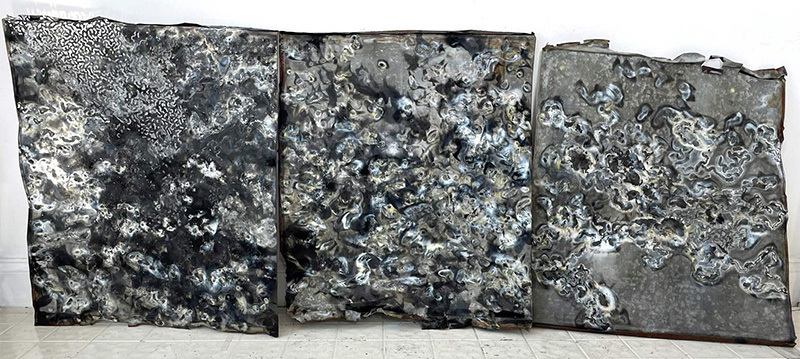 Marieken Cochius, Blowtorch drawing on antique zinc roofing: Triptych, 2024, zinc, metal, 29 x 23 x 0.5 in.
Marieken Cochius, Blowtorch drawing on antique zinc roofing: Triptych, 2024, zinc, metal, 29 x 23 x 0.5 in.
How Artist Marieken Cochius Lets Intuition Drive Her Creativity
Featured Artist Marieken Cochius’ large, welded artworks are detailed and intense. Like a root system unearthed from the ground, or an eddy swirling as the tide comes in, her metal pieces feel like energy flowing.
The shapes and paths that make up her art don't come from any intricately plotted plan, however. Instead, she tries to let wonder and excitement lead the work, and not put too many labels on it.
“Someone gave me a great compliment at one of my shows,” Marieken recounts. “This man said, staring at my work, ‘You don’t know what you are doing. And you are very good at it.’”
That state of intuitive creation is one that Marieken strives for when she’s making art—let the work lead and you'll be surprised where it takes you. But over the years that she’s been working as an artist, she’s come to realize that a healthy dose of order can also do wonders for her creative life.
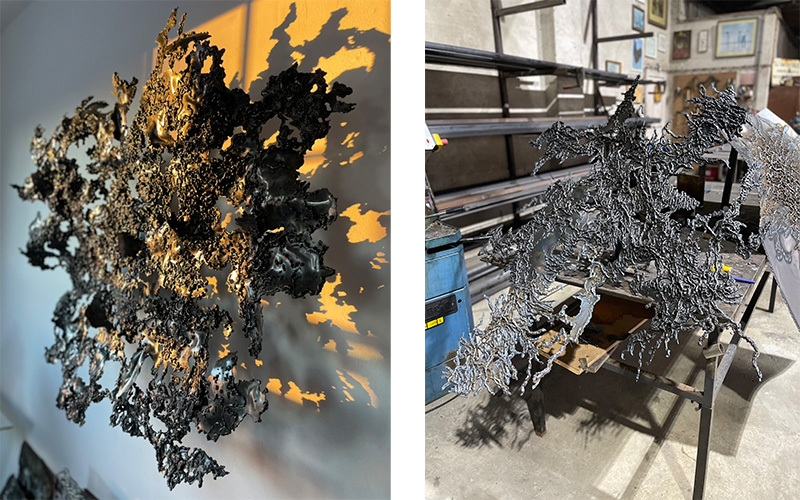 Marieken found her artistic calling with her signature "welded drawings."
Marieken found her artistic calling with her signature "welded drawings."
How to Find Your Artistic Inspiration
Marieken was lucky to find her medium early. It was the early 2000s and she had a seasonal job in a prop shop.
“The shop built the Christmas display windows for major stores in NYC with moving scenery and puppets,” the artist recounts, “and I worked in the metal department.” It was there that she learned how to weld, and she quickly found that she loved working with metal.
“Working with motors, milling metal, fabrication welding: it was awesome,” she says. “I would have paid to do that job.”
Fast forward two decades, and the skills she started to cultivate at that lucky job are the ones she now uses to create her finely wraught pieces out of metal.
An Artist’s Journey Is Not Always Linear
Even though she knew her love of metal would be valuable, life had a way of taking Marieken down other paths. It was twenty years before she got a welder of her own, and built a small metal shop out of the back of her home in the Hudson Valley, New York.
“I knew the basics 20 years ago and when I started I had to re-learn and invent,” she explains.
Marieken took a practical approach to her experiments, at the same time that she pushed her tools to their limits. She adopted a scientist’s method and an artist’s eye. “I made test strips, Iike I used to do as a photographer,” she says. “Seeing what shapes, thicknesses, etc. I could make with the welding gun.”
Eventually, she found her ideal working process, and her calling card as an artist: “I use a welder like a drawing tool, building up forms of molten welding wire on steel sheets before cutting them free with a torch. I see my handwriting in all my work, whether it is in ink or oil paint or metal,” she says. “I call it abstract organic.”
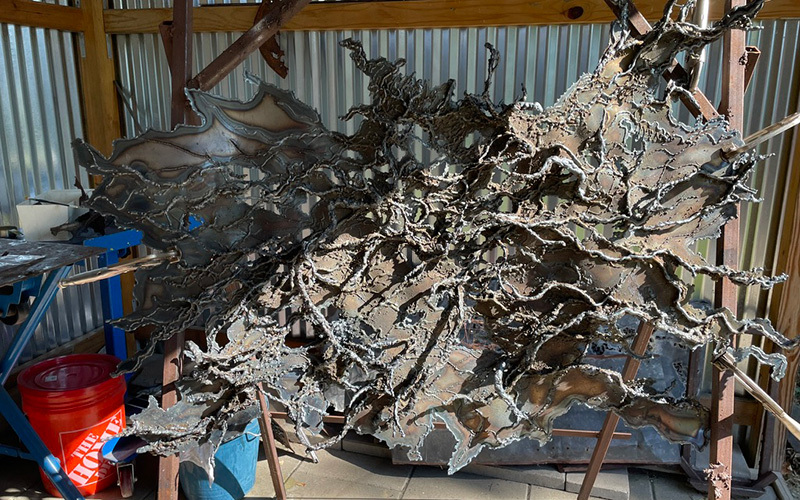
A large welded artwork in Marieken's backyard welding shop.
Finding the Words to Talk About Your Art
“I am an art school drop-out,” Marieken told Artwork Archive bluntly. That means she missed out on learning a lot of the things that can go into creating a sustainable art career. Early in her art practice, she never really formulated any plans, and didn’t know how to put her art in the right contexts. And she definitely didn’t want to write about her art.
“Writing my first art statements took years,” she says. She thinks she was at least a little bit afraid of what the writing might reveal, and that it might change how she approached the work itself. For such an intuitive artist, putting too much language to the work felt like it might limit her creativity.
“I learned to negotiate this path, observing, trying to answer questions about what I do and being true to myself,” she says, of the long journey to writing about her work. “As I learned to talk and write about my work it did show me something new every time: a bit more clarity each time.”
She used to dread it, but with patient practice, writing started to reveal things about her practice that she hadn’t been able to realize any other way.
“In my latest writing this came out: My work is rooted in the paths energy takes,” she says. “And that I think is a big truth: I want to make something that is alive.”
Let Your Art Documents Work For You
As an artist, you have a lot of important documents that keep your business running smoothly, from artist statements and bios to proposals and tax records. With Artwork Archive's My Docs feature, you can simplify your document management and streamline your workflow.
The next time a collector asks for your CV, or wants to know more about your artist statement, you'll have just the right documents easily accessible from your Artwork Archive account.
Creating the Right Conditions for Artistic Creativity
When Marieken begins a new artwork, she doesn’t start with a firm plan or an already thought out idea.
“When I start a new work, be it a new welding piece, a drawing, or painting, I do not have an image in my mind,” she told us. “I might think of a movement or sometimes a color, but the creative process is always ongoing for me.”
Instead, when she sits down to make a work, it’s all about setting the right conditions for creativity. She needs stillness, attention, calm—all the things that allow the busy world to go silent for a bit, and the artistic inspiration to come forth.
“Making always starts by quieting my mind and focusing on the tip of the welding gun, or pencil, and seeing what wants to come out,” she says. “It feels like going underwater, shutting out the world.”
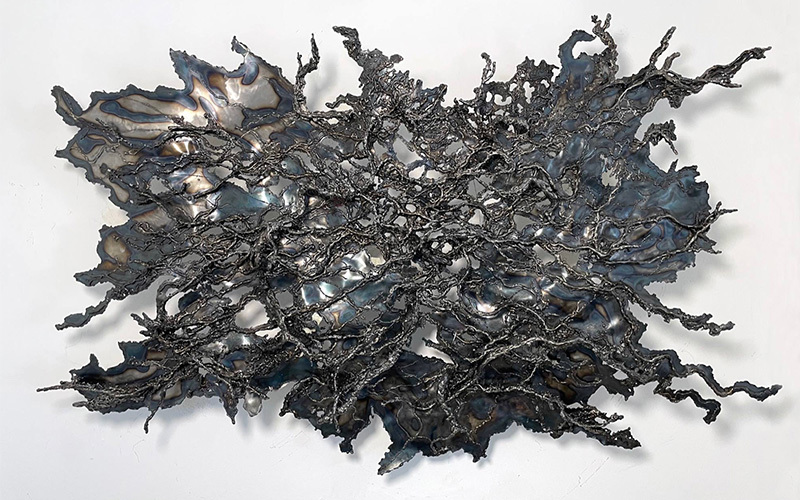 Marieken Cochius, Welded Drawing #46 - Sinews, 2024, Welded steel, 30 x 47 x 9 in.
Marieken Cochius, Welded Drawing #46 - Sinews, 2024, Welded steel, 30 x 47 x 9 in.
Keep Your Mind Open to New Artistic Directions
When she’s making her work, she’s found that it’s important to let the art lead. When she starts trying to think her way through a problem, it just doesn’t work.
“My brain has a tendency to want to help, but it is not the right tool for making art,” she explains. “If I listen to it, my work becomes wallpaper: designed, not alive. Learning to keep my brain out of making art is an ongoing thing.”
When she is able to quiet the mind enough, then the real reward follows. “My favorite part is the focus during the making, the calm I feel,” she says. “I need to do this in order to live.”
Plus, it’s just better to feel surprised by your work, rather than feel like you’re only going through the motions. Marieken has certainly found that her best work feels like creating paths of energy: “roots, wind, water, intergalactic dendrites whatever comes out intuitively.”
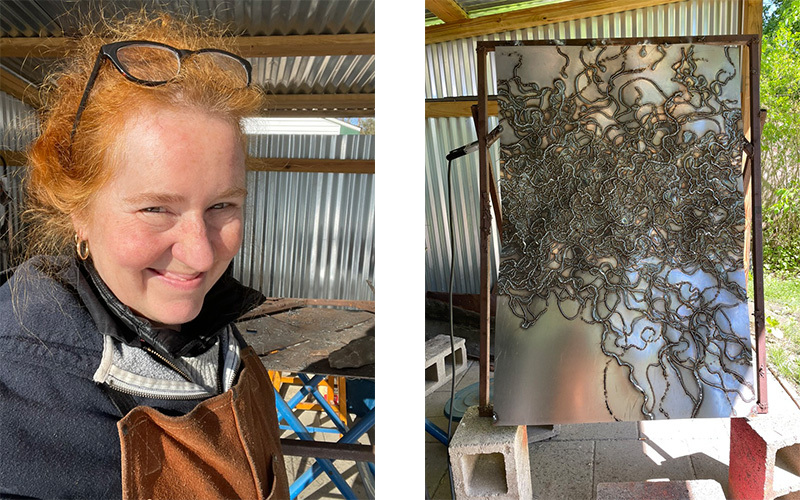
“My favorite part is the focus during the making, the calm I feel," Marieken explains.
Getting Organized Can Make Creativity Easier
Marieken has put so much ingenuity and grit into her art, she wants to make sure it reaches as wide of an audience as possible. When she was starting out as an artist, she knew she had to keep a good inventory of her work, but she struggled with all the administrative work.
In disorganized and unwieldy spreadsheets and databases, she was trying her best: “I was keeping track of sizes, dates, sales, shows, etc. It was so much work.”
When she found out about Artwork Archive, an art business solution created specifically for artists, she was intrigued. “I grilled the representative,” Marieken says. “What sold me in the end was that even if I decided to leave, I could download all my work I had put in.”
As she began organizing her work within Artwork Archive, she was so relieved by all the other tools that can ease her art admin. “When I started working with Artwork Archive it was really only to have a database,” she admits. "But now I am constantly surprised at all the other things you can do with it as well.”
It took a bit of time to get all her work into Artwork Archive, but that initial investment has definitely paid off in the peace of mind that she now has about her art career. “This summer I am in 7 shows, including a solo show,” she told us (busy artist!). “Keeping track of which works are available for these shows, getting notifications when I need to ship pieces out to these shows, when openings happen, recording sales, etc.”—all features standard with any Artwork Archive plan—"are fantastic.”
Use Tags to Tame Your Art Chaos
If you work in multiple mediums, or have multiple subjects, or just want to sort your work into different categories, Artwork Archive’s Tags feature is for you. You can create your own tags, filter your inventory, and so much more—give it a try today.
Dealing With Rejection Like a True Artist
Marieken’s full exhibition schedule isn’t just down to her amazing art. She’s also diligent about applying to opportunities, even if she knows the odds aren’t always with her.
“A friend told me this,” she says. “He had an English writing professor, and at the beginning of the semester this man said: ‘You only have one assignment for this year. By the end of the year you need to have 50 letters of rejection. And they better be from good places.’”
That’s a lesson that Marieken has taken to heart for her own practice. “I apply and forget. Next. 49 more to go.”
She has realized that when you send applications out into the world, more often than not, you’ll get a “yes.” “It is like throwing pebbles in a pond,” she says. “At some point the rings in the water come back to shore.”
Find Your Next Artist Opportunity Today
Each year the Artwork Archive team goes on a mission to find the best art opportunities, grants, and calls-for-entry for the upcoming year. Whether you're just starting out as an artist, or you've been creating for years, we have the opportunity for you—find the next great step for your career today!
Take Your Artwork Seriously—The World Will Follow Suit
If Marieken had any lasting message to share with artists, it’s to realize how important their artwork is and to protect it accordingly.
“Take care of your art after you make it,” she says. “Store it so it doesn’t get dust or scratches. Get the acid free glassine envelopes, corners for paintings, pillowcases for small sculptures.”
And a vital part of ensuring your artistic legacy is to keep good track of your artworks. “Keep track of how you made it, what finishes you used, all the things that were important for the creation of the work,” she urges artists. “And yes, start Artwork Archive.”
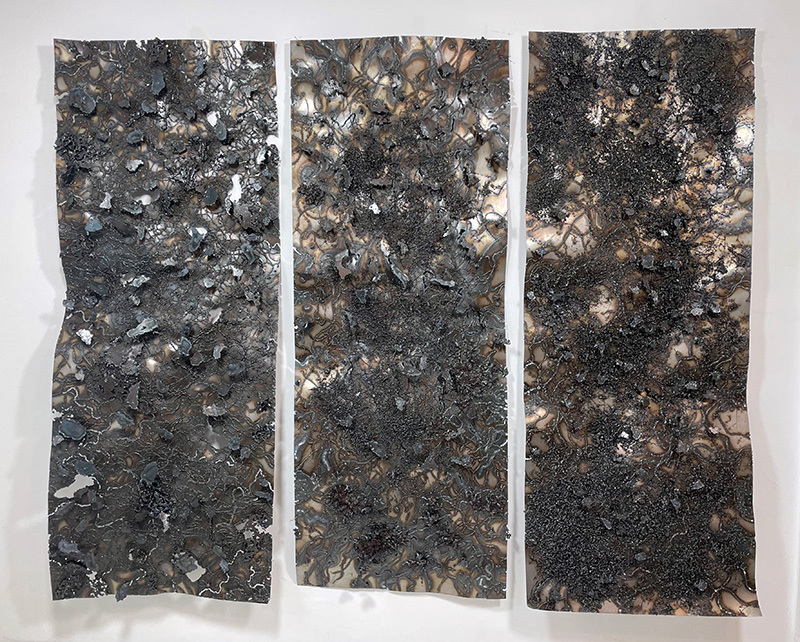 Marieken Cochius, Triptych of the Universe, 2025, 62 x 78 x 7 in.
Marieken Cochius, Triptych of the Universe, 2025, 62 x 78 x 7 in.
No matter where you are in your art journey, getting your business side in order doesn’t have to feel overwhelming. A bit of structure now can mean more time and headspace for the work you actually want to be doing.
Artwork Archive helps artists build an online portfolio, stay on top of their inventory, and create things like tear sheets and invoices in just a few clicks. Start a free trial and see how it fits into your own process.
